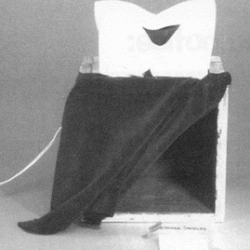Source Institutions
Source Institutions
Add to list Go to activity
Activity link broken? See if it's at the internet archive

Learners observe different paper samples under ordinary room light and under a black light to learn some of the chemical differences between different types of paper. They also learn that some chemicals can be identified by how they appear under a black light. For instance, fibers that can be seen only under ultraviolet light can be added to paper for security reasons.
- 5 to 10 minutes
- 10 to 30 minutes
- Over $20 per group of students
- Ages 6 - adult
- Activity, Experiment/Lab Activity
- English
Quick Guide
Materials List (per group of students)
- One view box (see Materials Prep, Unit 6 Experiment “Light and Dark”)
- Four 1-in. by 4-in. pieces of paper; each strip should be from a different type of paper that glows a different hue when placed under black light. (We used Boise Cascade Papers: Summit Form Bond (White Hi-Opaque), White 25% Cotton Laser, White Laser Opaque, and White OCR Laser Bond.)
- String or nylon fishing line
- Spray cleaner (such as Formula 409TM) (from general storage)
- Tissues
Subjects
-
Physical Sciences
- Chemistry
-
Vibration and Waves
- Light and Optics
- Structure and Properties of Matter
Informal Categories
- Crime Science
Audience
To use this activity, learners need to:
- see
- see color
- touch
Learning styles supported:
- Involves hands-on or lab activities
Other
This resource is part of:
Access Rights:
- Free access
By:
Rights:
- All rights reserved, Oregon Museum of Science and Industry, 1997
Funding Source:
- National Science Foundation
